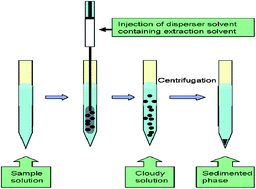Dispersive liquid–liquid microextraction combined with flame atomic absorption spectrometry for determination of cadmium in environmental, water and food samples
Abstract
A simple and reliable method for rapid and selective

* Corresponding authors
a
Department of Analytical Chemistry, Faculty of Sciences, University of Málaga, Málaga, Spain
E-mail:
fsanchezr@uma.es
Fax: +34952132000
Tel: +34952137393
A simple and reliable method for rapid and selective

 Please wait while we load your content...
Something went wrong. Try again?
Please wait while we load your content...
Something went wrong. Try again?
F. S. Rojas, C. B. Ojeda and J. M. C. Pavón, Anal. Methods, 2011, 3, 1652 DOI: 10.1039/C1AY05188A
To request permission to reproduce material from this article, please go to the Copyright Clearance Center request page.
If you are an author contributing to an RSC publication, you do not need to request permission provided correct acknowledgement is given.
If you are the author of this article, you do not need to request permission to reproduce figures and diagrams provided correct acknowledgement is given. If you want to reproduce the whole article in a third-party publication (excluding your thesis/dissertation for which permission is not required) please go to the Copyright Clearance Center request page.
Read more about how to correctly acknowledge RSC content.
 Fetching data from CrossRef.
Fetching data from CrossRef.
This may take some time to load.
Loading related content
